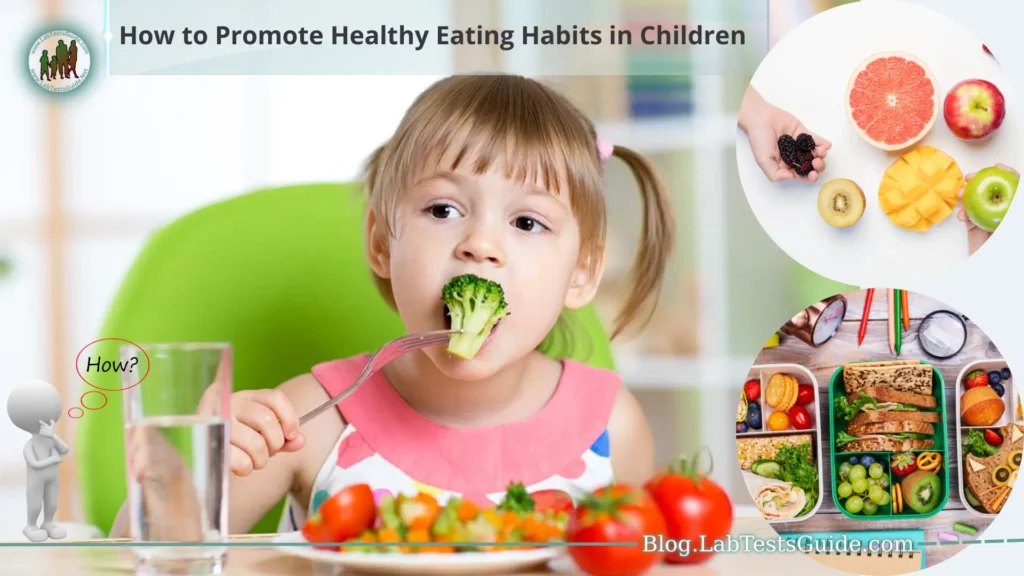Promoting healthy eating habits in children is of paramount importance as it lays the foundation for their overall well-being and development. Proper nutrition during childhood not only supports physical growth but also enhances cognitive function, immune system strength, and emotional stability. Unfortunately, the prevalence of unhealthy dietary patterns and the rise of childhood obesity have become major concerns in recent years. Therefore, it is crucial for parents, caregivers, educators, and communities to come together and take proactive steps to instill healthy eating habits in our young ones.

In this guide, we will explore effective strategies to encourage and foster healthy eating habits in children. By understanding the significance of balanced nutrition and the role of parents and caregivers in shaping children’s eating behaviors, we can create a positive food environment that promotes lifelong wellness.
What Is Healthy Eating for Children?
- Nutrient-Rich Foods: Healthy eating for children involves providing foods that are rich in essential nutrients, such as vitamins, minerals, and fiber. These include fruits, vegetables, whole grains, lean proteins, and dairy products.
- Balanced Diet: It emphasizes the importance of offering a balanced diet that includes foods from all food groups. This ensures that children get a variety of nutrients necessary for their growth and development.
- Limiting Sugary and Processed Foods: Healthy eating encourages reducing the intake of sugary snacks, candies, sodas, and processed foods that are high in added sugars, unhealthy fats, and sodium.
- Appropriate Portion Sizes: Teaching children about portion control helps them understand how much of each food they should eat to maintain a healthy weight and avoid overeating.
- Hydration: Emphasizing the importance of drinking water and limiting sugary beverages is a part of healthy eating for children to maintain proper hydration.
- Avoiding Unhealthy Fats: Reducing the consumption of trans fats and saturated fats found in fried and fatty foods is essential for heart health.
- Encouraging Regular Meals: Promoting the habit of having regular meals, including breakfast, helps in providing sustained energy throughout the day.
- Involving Children in Food Choices: Engaging children in meal planning and grocery shopping can make them more enthusiastic about healthy eating and give them a sense of ownership over their food choices.
- Setting a Positive Food Environment: Creating an environment at home and school that supports healthy eating by keeping healthy snacks readily available and minimizing the presence of unhealthy foods.
- Nutrition Education: Educating children about the importance of different nutrients and how they benefit their bodies can help them make informed decisions about their food choices.
How to Foster Healthy Eating Habits in Children:
Here are some effective strategies to promote healthy eating habits in children.
- Lead by Example: Children often model their behavior after adults. Demonstrate healthy eating habits by consuming a balanced diet, including fruits, vegetables, whole grains, and lean proteins, and limiting unhealthy snacks and sugary drinks.
- Involve Children in Meal Preparation: Engage children in age-appropriate meal planning and preparation. Let them choose healthy ingredients and participate in cooking activities, making them more invested in their meals.
- Create a Positive Food Environment: Stock the kitchen with nutritious snacks and limit the availability of unhealthy options. Make healthy foods easily accessible and appealing to children.
- Educate About Nutrition: Teach children about the benefits of different food groups and why a balanced diet is essential for their growth and energy. Use age-appropriate language and visuals to make learning fun.
- Make Healthy Eating Fun: Present fruits and vegetables in creative ways, such as making fruit skewers or arranging veggies into smiley faces. Turn mealtimes into enjoyable experiences that children look forward to.
- Encourage Family Meals: Aim to have regular family meals together. Eating as a family promotes bonding and provides an opportunity to model healthy eating habits.
- Limit Processed Foods and Sugary Drinks: Minimize the consumption of processed foods, fast food, and sugary beverages. Instead, offer water, milk, or unsweetened alternatives.
- Be Patient with Picky Eaters: It’s normal for children to be selective about their food choices. Offer a variety of healthy options, and don’t force them to eat. Encourage them to try new foods gradually.
- Avoid Using Food as a Reward: Refrain from using unhealthy treats as rewards for good behavior. Instead, find non-food rewards to encourage positive behavior.
- Teach Portion Control: Help children understand appropriate portion sizes to avoid overeating. Encourage them to listen to their body’s hunger and fullness cues.
- Be Mindful of Screen Time: Limit screen time during meals to avoid distractions and encourage mindful eating.
- Promote Physical Activity: Encourage regular physical activity to complement healthy eating habits and support overall health.
- Celebrate Progress: Acknowledge and praise children for making healthier food choices. Celebrate their efforts and successes, no matter how small.
Role of Parents and Caregivers:
- Setting a Positive Example: Parents and caregivers serve as role models for children. By consistently demonstrating healthy eating habits themselves, they can inspire children to follow suit.
- Meal Planning and Preparation: Involve children in meal planning and preparation. This not only gives them a sense of ownership over their food choices but also helps them understand the importance of nutritious meals.
- Creating a Supportive Food Environment: Ensure that the home environment is conducive to healthy eating. Keep a variety of nutritious foods readily available and limit the availability of unhealthy snacks and sugary beverages.
- Providing Nutritious Options: Offer a balanced diet that includes a variety of fruits, vegetables, whole grains, lean proteins, and dairy products to provide essential nutrients for growth and development.
- Nutrition Education: Educate children about the benefits of different foods and the importance of a balanced diet. Explain why certain foods are better for their bodies and how they contribute to overall health.
- Encouraging Healthy Snacking: Promote healthy snacking options, such as fruits, vegetables, and nuts, while minimizing the consumption of sugary snacks and processed foods.
- Limiting Unhealthy Choices: Set limits on the intake of processed foods, fast food, and sugary beverages, and explain why these should be occasional treats rather than regular choices.
- Being Patient with Picky Eaters: Understand that children may be selective about their food choices. Avoid pressure or force and instead, introduce new foods gradually and with patience.
- Family Meals: Aim to have regular family meals together. Eating as a family not only fosters communication but also provides an opportunity to model healthy eating habits.
- Promoting Mindful Eating: Encourage children to eat slowly and pay attention to their hunger and fullness cues, fostering a healthy relationship with food.
- Celebrating Healthy Choices: Celebrate and praise children for making healthy food choices. Positive reinforcement encourages them to continue making nutritious decisions.
- Educating on Hydration: Teach children about the importance of staying hydrated and the benefits of drinking water throughout the day.
- Supporting Physical Activity: Encourage regular physical activity as a complement to healthy eating, promoting overall well-being.
Educating Children about Nutrition:
- Age-Appropriate Language: Use language that is suitable for the child’s age and comprehension level. Explain complex concepts in simple terms to make it easy for them to understand.
- Food Groups and Balanced Meals: Introduce children to the concept of food groups, such as fruits, vegetables, grains, proteins, and dairy. Teach them about the importance of including foods from each group in their meals to achieve a balanced diet.
- Interactive Learning: Make nutrition education interactive and engaging. Use visuals, charts, and props to help children visualize different foods and their nutritional benefits.
- Storytelling and Games: Create stories or games centered around healthy eating and nutrition. This can make the learning process enjoyable and memorable for children.
- Cooking Activities: Involve children in cooking activities and use this opportunity to explain the nutritional value of the ingredients being used. Show them how cooking can be both fun and healthy.
- Garden or Farm Visits: If possible, take children to gardens or farms where they can see how fruits and vegetables are grown. This can spark their interest in fresh produce and healthier food choices.
- Label Reading: Teach older children to read food labels. Help them understand how to identify nutrients and recognize hidden sugars or unhealthy additives in packaged foods.
- Explain the Importance of Each Nutrient: Discuss the roles of various nutrients, such as vitamins, minerals, proteins, carbohydrates, and fats, in promoting overall health.
- Discuss Food Benefits: Emphasize the benefits of different foods. For example, explain how calcium in milk helps build strong bones or how vitamin C in oranges boosts the immune system.
- Healthy Food Challenges: Organize fun challenges where children are encouraged to try new fruits, vegetables, or other nutritious foods. This can make trying healthy foods exciting and less intimidating.
- Field Trips to Healthy Food Outlets: Take children to farmer’s markets, grocery stores, or restaurants that offer nutritious options. This can help them associate healthy food with positive experiences.
- Nutrition-themed Activities: Incorporate nutrition themes into arts and crafts, such as creating food pyramids or designing healthy meal plates.
- Parent Involvement: Encourage parents to reinforce nutrition education at home and support their children in making healthier food choices.
Making Healthy Eating Fun and Engaging:
- Colorful and Creative Presentation: Use a variety of colorful fruits and vegetables to create visually appealing dishes. Arrange them in fun shapes or make colorful fruit and veggie skewers.
- Food Art and Designs: Turn mealtime into a creative activity by letting children design their own food art. Encourage them to create faces or patterns using different food items.
- Cooking and Baking Together: Involve children in age-appropriate cooking and baking activities. Let them assist in measuring, mixing, and decorating healthy dishes, sparking their interest in nutritious foods.
- Healthy Snack Stations: Set up snack stations with a selection of healthy options like carrot sticks, cucumber slices, and whole-grain crackers. Let children choose their snacks, making it feel like a mini buffet.
- Food Tasting Games: Organize taste-testing games where children can sample new fruits, vegetables, or healthy dips. Encourage them to rate and describe the flavors they experience.
- Smoothie Creations: Allow children to create their own smoothie combinations using a variety of fruits, leafy greens, and yogurt. This promotes experimentation and a love for nutrient-packed beverages.
- Garden to Table Experience: If possible, start a small garden and involve children in growing herbs or vegetables. Harvesting and using their own produce can be a rewarding and educational experience.
- Theme Days or Weeks: Introduce themed meal days like “Taco Tuesday” or “Pasta Party” with nutritious variations. This adds an element of excitement and anticipation for mealtime.
- Healthy Food Challenges: Create fun challenges where children try to incorporate a certain color or type of food into each meal of the day.
- Storytelling with Healthy Foods: Introduce stories where characters go on adventures to find and enjoy healthy foods. This fosters positive associations with nutritious choices.
- Picky Eater Picnics: Organize a picnic with a selection of healthy finger foods. Allow picky eaters to explore and taste foods at their own pace in a relaxed outdoor setting.
- Cooking Contests: Organize family cooking contests where each member prepares a healthy dish. Children will enjoy being a part of the competition and tasting different creations.
Limiting Processed and Unhealthy Foods:
- Educate About Processed Foods: Teach children about the negative effects of processed foods on their health. Explain how these foods often contain high levels of added sugars, unhealthy fats, and artificial ingredients.
- Read Food Labels Together: Involve children in reading food labels to identify processed foods and understand their nutritional content. Encourage them to look for products with fewer additives and preservatives.
- Stock Healthy Alternatives: Keep the kitchen stocked with nutritious snacks like fresh fruits, vegetables, whole-grain crackers, nuts, and yogurt. These options can replace processed snacks like chips and cookies.
- Minimize Sugary Beverages: Limit the intake of sugary drinks such as soda, sports drinks, and fruit juices. Instead, promote water, milk, or natural fruit-infused water as healthier alternatives.
- Homemade Substitutes: Prepare homemade versions of favorite processed snacks, such as baked sweet potato fries instead of store-bought chips or homemade granola bars instead of packaged ones.
- Moderate Fast Food and Takeout: Reduce the frequency of fast-food meals and takeout. Reserve them for occasional treats rather than regular options.
- Meal Prepping: Plan and prepare balanced meals at home. This way, children are less likely to rely on processed convenience foods.
- Teach Smart Choices at Restaurants: When dining out, guide children in making healthier choices from the menu. Encourage them to opt for salads, grilled proteins, and whole-grain options.
- Be a Role Model: Demonstrate a preference for nutritious, whole foods in your own choices, reinforcing the importance of healthy eating.
- Explain Portion Control: Teach children about portion sizes, helping them understand that moderation is key, even with healthier snack options.
- Create a No-Junk-Food Zone: Designate a specific area in the house where processed and unhealthy snacks are not allowed. This helps minimize temptations.
- Limit Screen Time During Meals: Avoid distractions like TV, smartphones, or tablets during meals, as they can lead to mindless overeating or make children more susceptible to advertising of unhealthy foods.
Encouraging Regular Family Meals:
- Set a Schedule: Establish a consistent mealtime schedule that works for the entire family. Try to have at least one meal together every day, such as dinner or weekend brunch.
- Plan Together: Involve all family members in planning meals. Discuss menu options, preferences, and dietary restrictions, making everyone feel included in the decision-making process.
- Cook Together: Engage children in age-appropriate cooking tasks. Let them help with meal preparation, setting the table, or choosing ingredients. This strengthens family bonds and creates positive associations with mealtime.
- Create a Welcoming Atmosphere: Make mealtimes enjoyable by creating a warm and inviting atmosphere. Use placemats, candles, or soft music to set a cozy and pleasant ambiance.
- No Distractions: Encourage a distraction-free mealtime by keeping electronic devices off the table. This allows for meaningful conversations and connections between family members.
- Share Highlights of the Day: Use mealtime as an opportunity for family members to share their day’s experiences, challenges, and triumphs. This fosters communication and strengthens family relationships.
- Introduce New Foods: Use family meals as a chance to introduce new and nutritious foods. Encourage children to try small portions of unfamiliar dishes without pressure.
- Be Positive Role Models: Demonstrate healthy eating habits during family meals. Show enthusiasm for trying new foods and making balanced choices.
- Appreciate Efforts: Praise children for their contributions to meal preparation and for trying new foods, reinforcing positive behavior and self-confidence.
- Make it a Ritual: Establish family meals as a cherished ritual. Children are more likely to look forward to meals when they associate them with positive experiences and family togetherness.
- Discuss Food Origins: Spark curiosity and awareness by discussing where the food on the table comes from. Talk about the importance of local produce and sustainable choices.
- Family Fun Themes: Occasionally, introduce fun themes like “Mexican Fiesta Night” or “Italian Pasta Party.” This adds an element of excitement and keeps meals interesting.
- Invite Extended Family or Friends: On special occasions, invite extended family members or close friends to join family meals. This enhances social connections and creates lasting memories.
Promoting Healthy Eating at School:
- Offer Nutritious School Meals: Ensure that the school cafeteria provides a variety of balanced and nutritious meal options that include fruits, vegetables, whole grains, lean proteins, and low-fat dairy products.
- Limit Junk Food Availability: Minimize the availability of unhealthy snacks, sugary beverages, and vending machines with sugary or high-fat items on school premises.
- Educate Students about Nutrition: Incorporate nutrition education into the school curriculum, teaching students about the importance of healthy eating, food groups, and the benefits of making nutritious choices.
- Nutrition Workshops and Events: Organize nutrition workshops, cooking classes, or healthy eating challenges to engage students and raise awareness about the significance of healthy food choices.
- School Gardens: Establish a school garden where students can participate in growing fruits, vegetables, and herbs, fostering a connection with fresh and locally sourced produce.
- Healthy Celebrations and Rewards: Encourage teachers and parents to opt for healthy snacks or non-food rewards for classroom celebrations and student achievements.
- Lunchtime Environment: Create a pleasant and enjoyable atmosphere in the cafeteria, making lunchtime a positive experience for students.
- Role Models and Peer Influence: Involve teachers and staff as positive role models who demonstrate healthy eating habits. Encourage peer support and positive reinforcement for making nutritious choices.
- Healthy Vending Options: If vending machines are present on the premises, ensure they offer healthier alternatives, such as water, fruit cups, or unsalted nuts.
- Nutrition-Focused Posters and Displays: Decorate the school with posters and displays that promote healthy eating and provide information on the nutritional content of different foods.
- Incorporate Local and Seasonal Foods: Whenever possible, incorporate local and seasonal produce in school meals to promote sustainable choices and support local farmers.
- Parent Involvement: Engage parents in promoting healthy eating at school by sharing information about school nutrition programs and encouraging them to reinforce healthy habits at home.
Addressing Picky Eating and Food Challenges:
- Respect Their Preferences: Recognize that picky eating is a common behavior in children and respect their food preferences without forcing them to eat specific foods.
- Offer a Variety of Foods: Continue to expose children to a wide range of foods, including fruits, vegetables, proteins, and grains. Repeated exposure can increase the likelihood of them trying new foods.
- Use the “One Bite Rule”: Encourage children to take at least one bite of a new or disliked food. This allows them to become familiar with the taste and texture.
- Be Patient and Persistent: Avoid pressure or negative reactions when children reject certain foods. Be patient and keep offering a variety of foods over time.
- Make Meals Interactive: Involve children in meal preparation and cooking. Children may be more willing to try foods they helped prepare.
- Offer Food Choices: Give children some control over their meals by offering them a choice between two or three healthy options.
- Serve Familiar Foods Alongside New Foods: Include a familiar food on the plate along with new foods. This way, children have something they like while also being exposed to new flavors.
- Role Modeling: Demonstrate positive eating behaviors by eating a variety of foods yourself. Children are more likely to try new foods when they see others enjoying them.
- Avoid Using Food as a Reward or Punishment: Refrain from using food as a reward for eating certain foods or completing tasks. This can create negative associations with food.
- Encourage Sensory Exploration: Let children touch, smell, and explore new foods before eating. This can help them become more comfortable with unfamiliar textures and appearances.
- Stay Calm during Mealtimes: Keep mealtimes relaxed and stress-free. Avoid power struggles or negative reactions when children refuse certain foods.
- Make Healthy Food Fun: Present healthy foods in creative and fun ways, such as using cookie cutters to make shapes or arranging foods to create pictures.
FAQs:
Why is healthy eating important for children?
Healthy eating is crucial for children’s growth, development, and overall well-being. Proper nutrition supports physical growth, cognitive function, immune system strength, and emotional stability.
How can I encourage my child to try new foods?
Encourage your child to try new foods by offering them in small portions, involving them in meal preparation, and being a positive role model by trying new foods yourself.
What are some healthy snack options for children?
Healthy snack options include fruits, vegetables, nuts, yogurt, whole-grain crackers, cheese sticks, and hummus with carrot sticks.
How can I handle my child’s picky eating habits?
Handle picky eating by respecting their preferences, offering a variety of foods, involving them in meal planning, and using the “one bite rule” to encourage trying new foods.
How do I create a healthy food environment at home?
Create a healthy food environment by keeping nutritious snacks readily available, limiting unhealthy choices, and having regular family meals together.
How can I educate my child about nutrition in a fun way?
Educate children about nutrition in a fun way through food-based games, interactive activities, storytelling, and cooking together.
What can I do if my child is sensitive to certain foods or has allergies?
If your child has food sensitivities or allergies, work with a healthcare professional or a registered dietitian to identify safe and nutritious alternatives.
How can I limit my child’s intake of processed and unhealthy foods?
Limit processed and unhealthy foods by reading food labels, offering homemade substitutes, and creating a supportive food environment at home.
What are some healthy food options to pack for school lunches?
Healthy school lunch options include whole-grain sandwiches, cut fruits and vegetables, yogurt, nuts, and water or low-fat milk.
How can I involve my child in making healthy food choices?
Involve your child in making healthy food choices by taking them grocery shopping, letting them choose fruits and vegetables, and including them in meal planning.
Conclusion:
In conclusion, promoting healthy eating habits in children is a fundamental investment in their present and future well-being. By being positive role models, involving them in meal planning and preparation, and educating them about nutrition in an engaging manner, we can instill a love for nutritious foods and empower them to make informed food choices. Addressing picky eating challenges with patience and understanding, limiting processed and unhealthy foods, and encouraging regular family meals and positive food environments create a solid foundation for a healthier lifestyle. As parents, caregivers, educators, and communities work together to foster a culture of healthy eating, we pave the way for a generation of children who are physically, mentally, and emotionally nourished, setting them on a path towards a brighter and healthier future.






